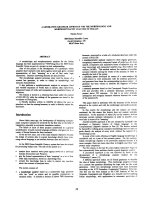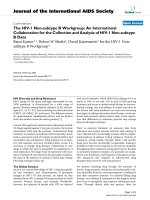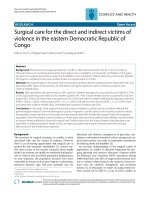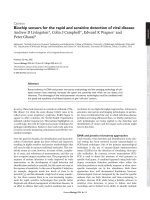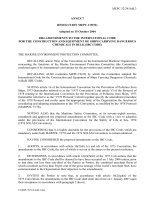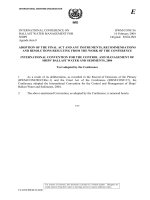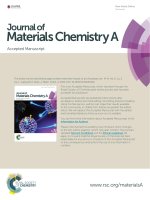International cooperation for the conservation and sustainable and fair use of biodiversity
Bạn đang xem bản rút gọn của tài liệu. Xem và tải ngay bản đầy đủ của tài liệu tại đây (2.16 MB, 219 trang )
Rheinische Friedrich-Wilhelms-Universit¨at Bonn
Institut f¨
ur Lebensmittel- und Ressourcen¨okonomik (ILR)
- und -
Zentrum f¨
ur Entwicklungsforschung (ZEF)
International Cooperation for the Conservation
and Sustainable and Fair Use of Biodiversity
Inaugural-Dissertation
zur
Erlangung des Grades
Doktorin der Agrarwissenschaften
(Dr. agr.)
der
Landwirtschaftlichen Fakult¨at
der
Rheinischen Friedrich-Wilhelms-Universit¨at Bonn
vorgelegt am 16. April 2015
von
Dipl.-Ing. agr. Sarah Margareta Winands-Kalkuhl, M.Sc.
aus
Bonn
Vorsitzender:
Prof. Dr. Jan B¨orner
Erstgutachterin:
Prof. Dr. Karin Holm-M¨
uller
Zweitgutachter:
Prof. Dr. Joachim von Braun
Fachnahes Mitglied:
Prof. Dr. Thomas Heckelei
Tag der m¨
undlichen Pr¨
ufung:
8. Juli 2015
Erscheinungsjahr:
2015
Danksagung
Ein ganz großer Dank geb¨
uhrt meiner Doktormutter Prof. Dr. Karin Holm-M¨
uller
f¨
ur die großartige F¨
orderung schon w¨ahrend meines Studiums, insbesondere als Betreuerin meiner Diplomarbeit, und anschließend meiner dreieinhalbj¨ahrigen Promotionszeit. Hierzu z¨
ahlen vor allem auch anregende Diskussionen und viele hilfreiche
Kommentare zu meiner Promotionsforschung. Zudem hat sie mir erm¨oglicht, an
einer Reihe nationaler und internationaler Konferenzen teilzunehmen. Als studentische Hilfskraft und wissenschaftliche Mitarbeiterin an ihrem Lehrstuhl durfte ich
u
¨berdies die universit¨
are Lehre kennenlernen. Sehr dankbar bin ich Frau Prof. Dr.
Holm-M¨
uller, dass sie meine Promotion neben meiner sp¨ateren außeruniversit¨aren
Berufst¨
atigkeit immer unterst¨
utzt hat.
Dem Zentrum f¨
ur Entwicklungsforschung der Universit¨at Bonn, insbesondere
dem Zweitgutachter meiner Promotion Prof. Dr. Joachim von Braun, danke ich
herzlichst f¨
ur die ansprechenden Vorlesungen und Kurse des Graduiertenkollegs.
Danken m¨
ochte ich ebenfalls Prof. Dr. Thomas Heckelei und meinem Betreuer
der Masterarbeit an der Universit¨at Wageningen und sp¨ateren Koautor Prof. Dr.
Hans-Peter Weikard f¨
ur Anregungen und Feedback zu meiner Forschung.
Allen Experten, die ich interviewen durfte, bin ich sehr verbunden, da sie sich
Zeit genommen und ihr Wissen mit mir geteilt haben. F¨
ur die Unterst¨
utzung bei
der Durchf¨
uhrung meiner Feldforschung in Peru danke ich neben meiner Doktormutter Prof. Dr. Karin Holm-M¨
uller zudem Dr. Lily Rodriguez und Elsa Cardona
Santos. Vier Kapitel dieser Arbeit habe ich als Artikel verfasst. Hierbei waren
die Kommentare von Reviewern und die Anregungen von Konferenzteilnehmern oftmals sehr hilfreich. Der Bischh¨
oflichen Studienf¨orderung Cusanuswerk danke ich f¨
ur
mein Promotionsstipendium, den großz¨
ugigen finanziellen Beitrag zur Durchf¨
uhrung
meiner Feldforschung und nicht zuletzt auch f¨
ur die ideelle F¨orderung.
Meinen Institutskolleginnen und -kollegen m¨ochte ich meinen Dank f¨
ur die freundschaftliche und gute Zusammenarbeit aussprechen. Hervorheben m¨oche ich Daniel
und Elsa, mit denen ich das B¨
uro teilen durfte. Meinen Freunden, insbesondere
i
ii
Danksagung
Christian, Gregor, Jan, Klara, Susanne, Thekla und Till, bin ich u
¨beraus dankbar
f¨
ur den R¨
uckhalt und die vielen anregenden Gespr¨ache w¨ahrend des Studiums und
der Promotionszeit.
Diese Promotionsschrift widme ich meinen Eltern. Ihre immerw¨ahrende Unterst¨
utzung und ihr großartiges Vertrauen in mich haben die Grundsteine f¨
ur meine
Entwicklung und schlussendlich meine Promotion gelegt. Auch meinem Bruder
und meinen Großeltern bin ich in tiefer Dankbarkeit verbunden. Ein großes und
besonderes Dankesch¨
on m¨
ochte ich meinem Ehemann Matthias aussprechen. Er hat
mich stets ermutigt und liebevoll unterst¨
utzt, die gleichzeitige Berufst¨atigkeit neben
meiner Promotion verst¨
andnisvollst mitgetragen und die Kapitel dieser Promotionsschrift Korrektur gelesen.
Contents
Summary
ix
Zusammenfassung
xi
List of Figures
xiii
List of Tables
xv
Abbreviations
xvii
1 Thesis Introduction
1
1.1
Motivation
. . . . . . . . . . . . . . . . . . . . . . . . . . . . . . . .
1
1.2
Objective and research questions . . . . . . . . . . . . . . . . . . . .
3
1.3
Methods . . . . . . . . . . . . . . . . . . . . . . . . . . . . . . . . . .
4
1.4
Outline . . . . . . . . . . . . . . . . . . . . . . . . . . . . . . . . . .
5
Bibliography . . . . . . . . . . . . . . . . . . . . . . . . . . . . . . . . . .
6
2 The Bigger Picture of Biodiversity and its Conservation and Sustainable and Fair Use
9
2.1
Introduction . . . . . . . . . . . . . . . . . . . . . . . . . . . . . . . .
9
2.2
The rationale for biodiversity conservation and sustainable and fair use 11
2.3
2.2.1
Biodiversity, ecosystem functioning, and ecosystem services .
11
2.2.2
Multiple values of biodiversity
. . . . . . . . . . . . . . . . .
18
2.2.3
The status and trends of global biodiversity . . . . . . . . . .
24
International cooperation under the Convention on Biological Diversity 27
2.3.1
The Convention on Biological Diversity . . . . . . . . . . . .
27
2.3.2
The Nagoya Protocol . . . . . . . . . . . . . . . . . . . . . . .
30
2.3.3
Biodiversity targets of the Convention on Biological Diversity
33
Bibliography . . . . . . . . . . . . . . . . . . . . . . . . . . . . . . . . . .
35
iii
iv
I
Contents
Modelling Cooperation for Biodiversity Conservation
43
3 The Biodiversity Conservation Game with Heterogeneous Countries
45
3.1
Introduction . . . . . . . . . . . . . . . . . . . . . . . . . . . . . . . .
45
3.2
Model characteristics: heterogeneity in attributes . . . . . . . . . . .
47
3.2.1
Heterogeneity in ecosystems . . . . . . . . . . . . . . . . . . .
47
3.2.2
Heterogeneity in wealth . . . . . . . . . . . . . . . . . . . . .
48
3.3
. . . . . . . . . . . . . . . . . . . . . . . . . . . . . . . .
50
3.3.1
Continuous biodiversity conservation choice . . . . . . . . . .
50
3.3.2
Biodiversity conservation pay-offs and outcome . . . . . . . .
51
3.3.3
The stage game of biodiversity conservation . . . . . . . . . .
53
Numerical appraisal . . . . . . . . . . . . . . . . . . . . . . . . . . .
56
3.4.1
Model application . . . . . . . . . . . . . . . . . . . . . . . .
57
3.4.2
Model results . . . . . . . . . . . . . . . . . . . . . . . . . . .
59
3.4.2.1
“Real World Scenario” results. . . . . . . . . . . . .
60
3.4.2.2
“Barrett Scenario” results. . . . . . . . . . . . . . .
62
Parameter analysis and discussion . . . . . . . . . . . . . . .
63
Conclusions . . . . . . . . . . . . . . . . . . . . . . . . . . . . . . . .
68
Appendix . . . . . . . . . . . . . . . . . . . . . . . . . . . . . . . . . . . .
70
3.A Parameter values of the analysis runs . . . . . . . . . . . . . . . . . .
70
3.A.1 Ecosystem quality parameters qi and yi : . . . . . . . . . . . .
70
3.A.2 Wealth parameter ωi : . . . . . . . . . . . . . . . . . . . . . .
71
3.A.3 Local benefit parameter v: . . . . . . . . . . . . . . . . . . . .
71
Bibliography . . . . . . . . . . . . . . . . . . . . . . . . . . . . . . . . . .
72
3.4
The Model
3.4.3
3.5
4 Are Benefit-Sharing Rules Based on the Game-Theoretic Paradigm
Applicable to International Environmental Agreements? The Case
of the Biodiversity Game.
75
4.1
Introduction . . . . . . . . . . . . . . . . . . . . . . . . . . . . . . . .
75
4.2
The game-theoretic model . . . . . . . . . . . . . . . . . . . . . . . .
78
4.2.1
The setting . . . . . . . . . . . . . . . . . . . . . . . . . . . .
78
4.2.2
The partition function and per-member partition function . .
79
4.2.3
Coalition stability . . . . . . . . . . . . . . . . . . . . . . . .
79
4.3
Application and appraisal of established per-member partition functions 80
4.3.1
Benefit surplus sharing rule . . . . . . . . . . . . . . . . . . .
80
4.3.2
Outside option based benefit-sharing rule . . . . . . . . . . .
82
Contents
4.3.3
Application obstacle: Information uncertainty about biodiversity benefits . . . . . . . . . . . . . . . . . . . . . . . . . . . .
83
Insights from empirical-qualitative research . . . . . . . . . . . . . .
87
4.4.1
Data collection and analysis . . . . . . . . . . . . . . . . . . .
87
4.4.2
Results . . . . . . . . . . . . . . . . . . . . . . . . . . . . . .
88
An alternative appraoch to benefit-sharing rules . . . . . . . . . . . .
92
4.5.1
Technical and political economy feasibility requirements . . .
92
4.5.2
A tentative determinant for the benefit shares
. . . . . . . .
95
. . . . . . . . . . . . . . . . . . . . . . . . . . . . . . . .
98
Bibliography . . . . . . . . . . . . . . . . . . . . . . . . . . . . . . . . . .
98
4.4
4.5
4.6
II
v
Conclusion
Multilateral Cooperation on the Genetic Resource Market 103
5 Eco-regional Cooperation on the Genetic Resource Market and the
Case of the Andean Community
105
5.1
Introduction . . . . . . . . . . . . . . . . . . . . . . . . . . . . . . . . 106
5.2
The genetic resource market under the CBD and its Nagoya Protocol 108
5.3
Dimensions of eco-regional cooperation . . . . . . . . . . . . . . . . . 110
5.4
Eco-regional cooperation advantages . . . . . . . . . . . . . . . . . . 112
5.5
5.4.1
Economies of scale . . . . . . . . . . . . . . . . . . . . . . . . 113
5.4.2
Other institutional advantages . . . . . . . . . . . . . . . . . 114
5.4.3
Market power and bargaining strength . . . . . . . . . . . . . 115
5.4.4
Impacts on the profits of cooperating countries . . . . . . . . 116
5.4.5
Indirect effects on the level of biodiversity conservation . . . 119
Case Study: The Andean Community’s cooperation in genetic resource trade . . . . . . . . . . . . . . . . . . . . . . . . . . . . . . . . 120
5.5.1
The Andean Community’s access regulation . . . . . . . . . . 121
5.5.2
Analysis of the Andean Community’s cooperation advantages 122
5.5.2.1
Potential cooperation advantages for the Andean Community . . . . . . . . . . . . . . . . . . . . . . . . . 123
5.5.2.2
The distribution of potential cooperation induced
benefits . . . . . . . . . . . . . . . . . . . . . . . . . 126
5.5.2.3
5.6
Conclusion
Realised cooperation advantages . . . . . . . . . . . 129
. . . . . . . . . . . . . . . . . . . . . . . . . . . . . . . . 130
Bibliography . . . . . . . . . . . . . . . . . . . . . . . . . . . . . . . . . . 132
vi
Contents
6 Bilateral vs. Multilateral? On the Economics and Politics of a
Global Mechanism for Genetic Resource Use
137
6.1
Introduction . . . . . . . . . . . . . . . . . . . . . . . . . . . . . . . . 138
6.2
Political and institutional background . . . . . . . . . . . . . . . . . 140
6.3
Economic analysis of the genetic resource market . . . . . . . . . . . 142
6.4
Empirical research methodology . . . . . . . . . . . . . . . . . . . . . 148
6.5
6.6
6.4.1
Data collection . . . . . . . . . . . . . . . . . . . . . . . . . . 149
6.4.2
Data analysis . . . . . . . . . . . . . . . . . . . . . . . . . . . 150
Empirical results on the political feasibility of a global mechanism . 152
6.5.1
The political debate on a global multilateral mechanism . . . 152
6.5.2
Results from the expert interviews on a global mechanism . . 155
Conclusion
. . . . . . . . . . . . . . . . . . . . . . . . . . . . . . . . 161
Appendix . . . . . . . . . . . . . . . . . . . . . . . . . . . . . . . . . . . . 162
6.A Appendix to Section 6.3 . . . . . . . . . . . . . . . . . . . . . . . . . 162
6.A.1 Demand side . . . . . . . . . . . . . . . . . . . . . . . . . . . 162
6.A.2 Supply side . . . . . . . . . . . . . . . . . . . . . . . . . . . . 163
6.A.3 Social optimum . . . . . . . . . . . . . . . . . . . . . . . . . . 164
Bibliography . . . . . . . . . . . . . . . . . . . . . . . . . . . . . . . . . . 165
7 Conclusion
7.1
169
Synthesis and contribution of the thesis . . . . . . . . . . . . . . . . 169
7.1.1
Methodological contribution to game theoretic modelling of
multilateral biodiversity conservation cooperation . . . . . . . 169
7.2
7.1.2
Findings on international biodiversity conservation coalitions
170
7.1.3
Findings on multilateral cooperation for genetic resource use
172
Outlook and suggestions for further research . . . . . . . . . . . . . . 174
Bibliography . . . . . . . . . . . . . . . . . . . . . . . . . . . . . . . . . . 176
Supplementary Material
179
Supplementary Material Chapter 3 . . . . . . . . . . . . . . . . . . . . . . 180
S.3.1
S.3.2
Stability analysis . . . . . . . . . . . . . . . . . . . . . . . . . 180
S.3.1
Stability analysis without transfers . . . . . . . . . . 180
S.3.2
Stability analysis with transfers . . . . . . . . . . . 181
Model results . . . . . . . . . . . . . . . . . . . . . . . . . . . 182
S.3.1
Model results for perfect ecosystem substitutability
182
S.3.2
Model results for imperfect ecosystem substitutability 184
Contents
vii
S.3.3
Model results for imperfect ecosystem complementarity185
Supplementary Material Chapter 4 . . . . . . . . . . . . . . . . . . . . . . 187
S.4.1
Topic guideline for the expert interviews . . . . . . . . . . . . 187
Supplementary Material Chapter 6 . . . . . . . . . . . . . . . . . . . . . . 189
S.6.1
S.6.2
Documents on Art. 10 of the Nagoya Protocol . . . . . . . . 189
S.6.1
UNEP/CBD documents . . . . . . . . . . . . . . . . 189
S.6.2
Other documents . . . . . . . . . . . . . . . . . . . . 191
Arguments against a Global Multilateral Benefit-Sharing
Mechanism (Art. 10, Nagoya Protocol) . . . . . . . . . . . . 192
S.6.3
Potential situations for a Global Multilateral Benefit-Sharing
Mechanism (Art. 10, Naogya Protocol) . . . . . . . . . . . . 195
S.6.4
Topic guideline for the expert interviews . . . . . . . . . . . . 197
Bibliography . . . . . . . . . . . . . . . . . . . . . . . . . . . . . . . . . . 197
Summary
This thesis contributes to the modelling of intergovernmental cooperation for global
biodiversity conservation and analyses multilateral cooperation on the genetic resource market. The inter- and transdisciplinary research consists of game theoretic
modelling, economic analyses, the study of political and legal documents, as well
as the conducting of expert interviews. The game theoretic biodiversity conservation model developed in this thesis considers countries that are heterogeneous in
ecosystems and wealth. The ecosystems are characterised by imperfect ecosystem
substitutability as well as an ecosystem resilience threshold and provide local as well
as global benefits. One of the main findings of the numerical appraisal is that cooperation improves upon the conservation share in the Nash equilibrium and optimal
transfers facilitate a large stable coalition. Moreover, it is evinced that established
‘per-member partition functions’ are currently not applicable to the biodiversity
conservation game. Based on expert interview results and technical feasibility and
political economy considerations, an alternative benefit-sharing rule is derived. It is
shown how this rule can be incorporated into the standard game-theoretic framework once countries have gained sufficient information to form expectations about
biodiversity benefits. The main finding on multilateral cooperation on the market
for physical genetic resources is that eco-regional cooperation and, even more so, a
comprehensive global mechanism have the potential to significantly reduce transaction costs for both supplying countries and customers. They can thereby decrease
prices for customers and increase demand, conservation levels and providers’ benefits. A case study of the Andean Community’s joint access legislation shows that the
member countries realise few of their potential cooperation advantages. Collusion
on the physical genetic resource market will not lead to high benefits as market
power is limited by substitutes in form of ex-situ resources and freely available
genetic information. The economically preferable instrument of a comprehensive
global mechanism, in turn, is politically not feasible any time soon due to path
dependencies and an arguably narrow understanding of national sovereignty.
ix
Zusammenfassung
Diese Dissertation erweitert bestehende Ans¨atze zur Modellierung von zwischenstaatlicher Kooperation f¨
ur den globalen Biodiversit¨atsschutz und analysiert multilaterale Kooperation auf dem Markt f¨
ur genetische Ressourcen. Die inter- und transdisziplin¨
are Forschung beruht auf spieltheoretischen Methoden, ¨okonomischen Analysen, der Auswertung politischer und juristischer Dokumente sowie der Durchf¨
uhrung von Experteninterviews. Das in dieser Dissertation entwickelte spieltheoreti¨
sche Biodiversit¨
atsschutz-Modell ber¨
ucksichtigt L¨ander, die heterogen in Okosyste¨
men und Wohlstand sind. Die Okosysteme
sind durch imperfekte Substituierbarkeit sowie Resilienzschwellen charakterisiert und stiften lokalen wie auch globalen
Nutzen. Eines der zentralen Ergebnisse der numerischen Absch¨atzung ist, dass Kooperation zu einer Verbesserung des Schutzniveaus im Vergleich zum Nash-Gleichgewicht f¨
uhrt und optimale Transferzahlungen eine große stabile Koalition beg¨
unstigen. Außerdem zeigt sich, dass etablierte ‘per-member partition functions’ (spieltheoretisch begr¨
undete Ausgleichszahlungen) zurzeit nicht auf das Biodiversit¨atsschutz-Spiel anwendbar sind. Basierend auf den Ergebnissen der Experteninterviews
und unter Ber¨
ucksichtigung der technischen Realisierbarkeit sowie polit-¨okonomischer Erw¨
agungen wird ein alternativer Bestimmungsfaktor f¨
ur den Vorteilsausgleich entwickelt. Dabei wird herausgearbeitet, wie diese Verteilungsregel in den
spieltheoretischen Standardmodellrahmen integriert werden kann, sobald die L¨ander
ausreichende Kenntnisse erworben haben, um den Nutzen der Biodiversit¨at zu bewerten. Das Hauptergebnis zu multilateraler Kooperation auf dem Markt f¨
ur physische genetische Ressourcen ist, dass ¨okoregionale Kooperation und vor allem ein umfassender globaler Mechanismus das Potential haben, die Transaktionskosten sowohl
f¨
ur Anbieterl¨
ander als auch Nutzer signifikant zu verringern. Dadurch k¨onnen sich
die Preise f¨
ur die Nutzer reduzieren und die Nachfrage, das Schutzniveau und die
Gewinne der Anbieterl¨
ander erh¨ohen. In einer Fallstudie zur Andengemeinschaft
wird aufgezeigt, dass die Mitgliedsl¨ander wenige ihrer potenziellen Kooperationsvorteile realisieren. Kollusion auf dem Markt f¨
ur physische genetische Ressourcen wird
keine hohen Gewinne erzielen, da die Marktmacht durch Substitute in Form von Exsitu Ressourcen und frei erh¨
altlicher genetischer Information limitiert ist. Das aus
¨okonomischer Sicht vorzuziehende Instrument eines umfassenden globalen Mechanismus wiederum ist politisch in absehbarer Zeit aufgrund von Pfadabh¨angigkeiten
und einem wohl engen Verst¨
andnis nationaler Souver¨anit¨at nicht durchsetzbar.
xi
List of Figures
2.1
Chapter and thesis outline . . . . . . . . . . . . . . . . . . . . . . . .
10
2.2
Conceptual framework . . . . . . . . . . . . . . . . . . . . . . . . . .
12
2.3
Extended conceptual framework . . . . . . . . . . . . . . . . . . . . .
19
2.4
Total economic value . . . . . . . . . . . . . . . . . . . . . . . . . . .
22
2.5
Species classification according to risk of extinction . . . . . . . . . .
25
2.6
Decline in global vertebrate species populations . . . . . . . . . . . .
26
3.1
Local benefits from biodiversity conservation . . . . . . . . . . . . .
60
3.2
Benefit isoquants with respect to conservation level . . . . . . . . . .
61
3.3
Local conservation and harvesting benefits . . . . . . . . . . . . . . .
66
4.1
Numerical application: Tentative determinant for the benefit shares
97
5.1
Eco-regional cooperation advantages . . . . . . . . . . . . . . . . . . 120
5.2
Correlation of WGI 2013 indicator values for the Andean Countries . 128
5.3
Relative institutional environment and biodiversity richness of the
Andean Community member countries . . . . . . . . . . . . . . . . . 128
6.1
Genetic resource market . . . . . . . . . . . . . . . . . . . . . . . . . 146
6.2
Empirical research methodology . . . . . . . . . . . . . . . . . . . . . 148
xiii
List of Tables
3.1
Stable coalitions of the Real World Scenario and the Barrett Scenario
59
3.2
Parameter values of the base scenario Real World Scenario . . . . . .
60
3.3
Parameter values of the Barrett Scenario . . . . . . . . . . . . . . . .
62
3.4
General trends in parameter impact . . . . . . . . . . . . . . . . . .
64
A.1 Parameter values for qi and yi in the different analysis runs . . . . .
71
A.2 Parameter values for ωi in the different analysis runs . . . . . . . . .
71
A.3 Parameter values for v in the different analysis runs . . . . . . . . .
72
5.1
Eco-regional cooperation advantages from cooperation elements . . . 117
5.2
Cooperating countries’ relative benefit shares . . . . . . . . . . . . . 118
5.3
Andean countries’ biodiversity richness and endemism . . . . . . . . 125
5.4
Relative institutional environment of the Andean countries . . . . . 127
S.3.1 Model results for perfect ecosystem substitutability . . . . . . . . . . 182
S.3.2 Model results for imperfect ecosystem substitutability . . . . . . . . 184
S.3.3 Model results for imperfect ecosystem complementarity . . . . . . . 185
xv
Abbreviations
ABS
Access and Benefit-Sharing
CAN
Andean Community (Spanish: Communidad Andina)
CBD
Convention on Biological Diversity
CES
Constant Elasticity of Substitution
CITES
Convention on International Trade in Endangered Species
of Wild Flora and Fauna
COP
Conference of the Parties
GDP
Gross Domestic Product
GEF
Global Environment Facility
EU
European Union
FAO
Food and Agriculture Organization of the United Nations
GBO
Global Biodiversity Outlook
GMBSM
Global Multilateral Benefit-Sharing Mechanism
GPS
Global Positioning System
iBOL
International Barcode of Life
ICNP
Open-ended Ad Hoc Intergovernmental Committee for the
Nagoya Protocol on Access to Genetic Resources and the
Fair and Equitable Sharing of Benefits Arising from their
Utilization
IEA
International Environmental Agreement
INBio
National Biodiversity Institute Costa Rica (Spanish: Instituto Nacional de Biodiversidad )
INSDC
International Nucleotide Sequence Database Collaboration
IPBES
Intergovernmental Platform on Biodiversity and Ecosystem
Services
ITPGRFA
International Treaty on Plant Genetic Resources for Food
and Agriculture
xvii
xviii
Abbreviations
IUCN
International Union for Conservation of Nature
LAC
Latin America and the Caribbean
LPI
Living Plant Index
MAT
Mutually Agreed Terms
MDGs
Millennium Development Goals
MEA
Millennium Ecosystem Assessment
MOP
Meeting of the Parties
NCBI
National Center for Biotechnology Information
NP
Nagoya Protocol on Access to Genetic Resources and the
Fair and Equitable Sharing of Benefits Arising from their
Utilization
OECD
Organisation for Economic Co-operation and Development
PIC
Prior Informed Consent
PSSS
Proportional Surplus Sharing Scheme
PSSVF
Proportional Surplus Sharing Valuation Function
R&D
Research and Development
SBI
Subsidiary Body on Implementation
SBSTTA
Subsidiary Body on Scientific, Technical and Technological
Advice
TEEB
The Economics of Ecosystems and Biodiversity
TEV
Total Economic Value
UNCED
United Nations Conference on Environment and Development
UNEP
United Nations Environment Programme
UNEP-WCMC
United Nations World Conservation Monitoring Centre
UNESCO
United Nations Educational, Scientific and Cultural Organization
WCED
World Commission on Environment and Development
WDI
World Development Indicator
WDPA
World Database on Protected Areas
WWF
World Wide Fund For Nature
“Cur tot creaturae, quae sunt imagines Dei, nisi ut veritas melius in
varietate explicetur, quae est, uti est, inexplicabilis?”
Why are there so many creatures, which are images of God, if not to express the truth better
in diversity, which, in itself, is inexpressible?
Nicholas of Cusa, Sermo CLXX, n. 8, 12-17
Chapter 1
Thesis Introduction
Biodiversity is essential for all living beings including humans. Its multi-layered
dimensions across local to global scales require a similarly multi-faceted reflection
in human actions. In this thesis I focus on the global scale and consider several
aspects of international cooperation for the conservation and sustainable and fair
use of biodiversity. In the following, I introduce the thesis’ motivation (Section
1.1), research objective (Section 1.2), and methods (Section 1.3), and outline the
subsequent chapters (Section 1.4).
1.1
Motivation
The motivation to study international cooperation for the conservation and sustainable and fair use of biodiversity is threefold. The first and broader underlying motive
1
2
Chapter 1. Thesis Introduction
is the apparent need for conserving biodiversity and using it sustainably. This follows
from the importance of biodiversity for life on earth in its present form in conjunction with the continued loss of biodiversity beyond sustainable levels, even beyond
‘planetary boundaries’ (as defined by Rockstr¨om et al. (2009), Steffen et al. (2015)).
Biodiversity increases ecosystem resilience (Holling (1973, p. 18), Folke et al. (1996,
p. 1020)), contributes to ecosystem functioning (Tilman 1999, p. 1470), and thereby
to ecosystem services and benefits (Balvanera et al. 2006, p. 1155). Biodiversity,
ecosystem functioning and ecosystem services have multiple ecocentric (Mazzotta
and Kline 1995) to anthropocentric values of immense size (TEEB 2010). However,
biodiversity decreases at rates higher than the average in geological time (Mace et al.
2005, p. 104).
The second motivation to focus on international biodiversity cooperation lies
in the demanding concept and nature of biodiversity. Biodiversity–or biological
diversity–is a multi-layered concept that includes genetic diversity, species diversity
and ecosystem diversity (CBD, Art. 1 ) and is characterised by different spatial and
temporal scales (Fisher et al. 2009, p. 648). Hence, it is difficult to operationalise
(Sarr et al. 2008, p. 185). The complex nature of biodiversity provides a challenge
for conserving biodiversity and using it sustainably.
The third motivation for this research is that the latter is especially demanding on the global scale. Albeit a large part of countries aspires strong cooperation,
in most cases national and international efforts to reach global consensus targets
for biodiversity conservation and sustainable use are not sufficient (UNEP 2014,
p. 10). Worldwide biodiversity conservation and sustainable use requires effective
self-enforcing cooperation by sovereign countries. The international community cooperates to this end under the United Nations ‘Convention on Biological Diversity’ 1
(CBD) and its ‘Nagoya Protocol on Access to Genetic Resources and the Fair and
Equitable Sharing of Benefits Arising from their Utilization’ 2 . Without a superior
enforcement authority such cooperation needs to be in the self-interest of every
cooperating country–and risks to merely codify the status-quo (Barrett 1994).
Together, the need for conservation and sustainable use of biodiversity, the multilayered demanding nature of biodiversity, and the challenging international cooperation, motivate my research on aspects of international cooperation for the conser1
United Nations (1992): Convention on Biological Diversity, 31 Int’l Leg. Mat. 818, Rio de
Janeiro, 05.06.1992.
2
United Nations (2010): Nagoya Protocol on Access to Genetic Resources and the Fair and Equitable Sharing of Benefits Arising from their Utilization to the Convention on Biological Diversity,
Nagoya, 29.10.2010.
Chapter 1. Thesis Introduction
3
vation and sustainable and fair use of biodiversity.
1.2
Objective and research questions
The objective of my thesis is twofold: (I) to contribute to the game theoretic modelling of cooperation for biodiversity conservation and (II) to analyse multilateral
cooperation for the internalisation of positive conservation externalities accruing to
genetic resource users3 .
Game theory can be a valuable tool to analyze cooperation incentives, strategic
interactions, and critical factors stabilising a biodiversity coalition. In contrast to
climate change, the other major global environmental cooperation challenge, the
game theoretic literature on international biodiversity agreements is relatively small.
Barrett’s (1994) ‘Biodiversity Supergame’ is the most influential model. It seems
to confirm that the CBD is unable to improve much upon global welfare compared
to the non-cooperative scenario. However, the result is based on restrictive model
assumptions (Weikard 2009, p. 578). Besides, established general game theoretic
benefit-sharing rules (i.a. Carraro et al. (2006), Weikard (2009), Eyckmans et al.
(2012)) may not be applicable to biodiversity conservation cooperation, because
of informational limitations due to ecological uncertainty and economic valuation
problems. Two sets of research questions thus relate to the first objective:
Q I.1 How can international cooperation for biodiversity conservation of sovereign
heterogeneous states be modelled game theoretically? How does heterogeneity
in wealth and imperfectly substitutable ecosystems impact the stability of international biodiversity conservation agreements among countries differing in
these two dimensions? How do local benefits, ecosystem resilience thresholds,
and transfers impact conservation levels and stability?
Q I.2 Are established sharing rules for coalition formation games (i.e. benefit surplus sharing rule, outside option sharing rule) applicable to the case of biodiversity conservation cooperation? If not, which ones are?
In the second part of the thesis I focus on international cooperation under the
CBD’s ‘Nagoya Protocol on Access to Genetic Resources and the Fair and Equitable
Sharing of Benefits Arising from their Utilization’. Hence, genetic diversity, which is
3
There are other positive externalities of biodiversity conservation. I focus only one those particular positive externalities that accrue to genetic resource users such as pharmaceutical firms.
